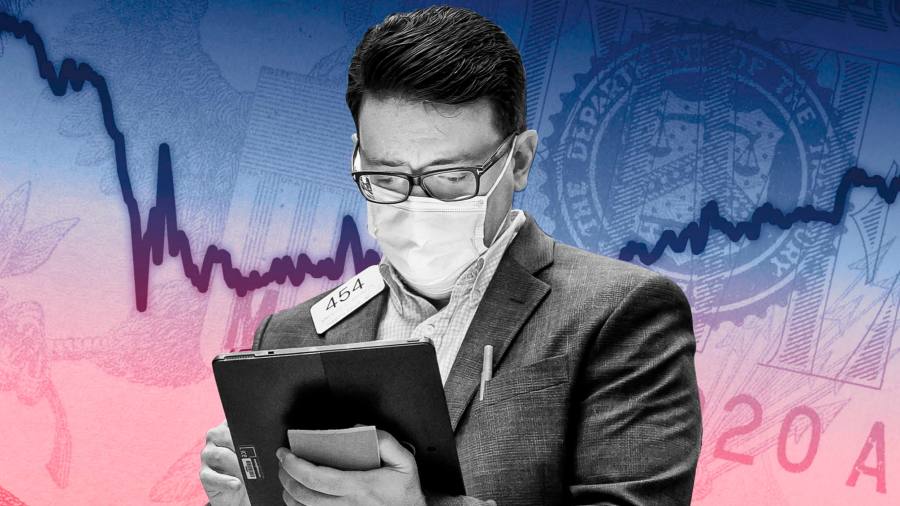Good morning. Goldman is firing people, and may even have to cut its spending on private planes. Early estimate of the number of non-Goldman people who are sad about this: 0. But finance is a leading indicator. If the bank is cutting back, everyone else will be doing the same before long. Enjoy your schadenfreude while you can, people. Email us: [email protected] and [email protected].
China: the other big story
It’s only a minor exaggeration to say every trade in 2022 boiled down to taking a view of inflation and the Fed. That story isn’t over, but with “transitory” buried and rates fast approaching 5 per cent, a lot of it has played out. If last year was a one-risk market, focus will be more divided in 2023.
One area, China, is already screaming for attention. The exit from zero-Covid-19, once expected to come in phases, has instead come all at once, bringing with it a catastrophic surge in Covid cases. The border with Hong Kong partly reopened last week and even more support to the flailing property sector is reportedly due soon, including relaxed enforcement of the “three red lines” policy that kicked off the acute phase of China’s property crisis.
For direct investors in China or Chinese companies, a fascinating debate is under way. Less than a year since we were all debating whether China was uninvestable, many Wall Street banks are arguing that a powerful recovery is coming — and is not yet priced in.
But even if you aren’t a China investor, the effect of Chinese reopening on global demand will matter. A successful reopening could, depending on the timing, dump demand into an inflationary global economy or prop up growth as other economies stall.
Starting with investors in Chinese assets, the ultimate prize is Chinese consumers’ vast store of savings. Estimates vary, but JPMorgan puts the figure at about Rmb5.6tn ($830bn) or 4.7 per cent of China’s nominal GDP, suggesting a big reservoir of pent-up demand once full reopening is upon us. Domestic-facing Chinese corporations stand to gain.
Bulls argue that the first wave of Covid cases may already be past its peak, so a spending surge may not be far off. Without reliable official data it is hard to tell, but an informal poll of 352 people across China by Ernan Cui of Gavekal Dragonomics found 80 per cent had already caught Covid. Goldman Sachs’ China research team cites Baidu search activity, arguing that the peak in Covid searches should roughly correspond with the peak in cases of Covid:
In any case, forward-looking financial markets might look past the precise trajectory of the virus, so long as it doesn’t completely derail reopening. (They are already starting to do so; the Shanghai composite is up 10 per cent from its October trough.) Looking at how markets and corporate earnings have reacted to viral development elsewhere in the world, Wendy Liu of JPMorgan writes:
Data show to our surprise that infection waves had limited impact on EPS revision trend and market return . . . average indices’ return over each infection wave was 0 per cent. It appears the market looks past subsequent infection waves once reopening is set in motion, and instead of giving back gains and cutting estimates, it consolidates and waits. This means that, for investors, it may make sense to downplay the Covid variants overhang and focus tracking underlying demand recovery, eg consumption, home sales and industrial activities.
If reopening continues apace, Chinese demand could roar back. As savings are spent, consumption will rise. With state support to the property sector also increasing, a temporary turnround could follow. The chart below shows two key measures of weakening demand, pointing to ample room for a reversal:
In this environment Chinese stock valuations look tempting, say the bulls. Bank of America’s Winnie Wu (no relation) notes that the MSCI China index, at 11 times forward earnings, is still 10 per cent below its long-run average. She expects both upward earnings revisions and multiple expansion to fuel China’s outperformance.
You can see the same point a different way by comparing lagging Chinese equity performance to a broad EM index. Here, too, mean-reversion would spell significant gains:
Going back to 2015, Chinese equities have traded right alongside those from the rest of the emerging world. But since early 2021, China has underperformed the rest of EM by 30 percentage points.
In sum: reopening is here, it will lift Chinese risk assets, peaking cases haven’t stopped it and the price looks right.
The bear case is rather less precise, but comes down to reopening being very hard, and very hard to predict. An even bigger second wave of Omicron cases, a politically intolerable death toll that prompts lockdowns, a collapsing healthcare system, a deadlier variant — any of these could blow apart market optimism. An on-again-off-again approach to lockdowns would crush the economy and shatter markets’ newfound confidence.
Assessing the probabilities here is nigh on impossible, so the bears’ strongest argument comes down to some old-fashioned epistemic modesty. As NatWest’s John Briggs puts it:
I can’t help but think that a population where 40 per cent of the elderly are not fully vaccinated, has been indoctrinated to fear Covid, and has seen a rapid spread of the virus since reopening will [not see consumption] go from 0 to 100 [ie, locked down to fully normal] in a straight line
Remember that just weeks ago, analysts, Unhedged included, assumed the zero-Covid exit would be phased in. We were all wildly wrong. The China Covid story is proving unpredictable, and we agree with Briggs that “China is one of, if not the largest, potential source of volatility and surprise in 2023”. With so much room for error 11 times forward earnings seems not so much cheap as fair.
Given the short-term dangers plus the many underlying weaknesses in the Chinese economy, Aninda Mitra, head of Asia macro at BNY Mellon Investment Management, made the point to us that investors need not rush into the reopening trade:
There are still long-term issues. We’ve heard the authorities want to relax the three red lines and some tech firms have been let off with a slap on the wrist. But the overarching approach to China’s structural issues is not clear just yet. I agree you can take [government] rhetoric at face value, and that probably works at a tactical level, but from a structural standpoint that’s what’s been holding us back. We will have time to go long China if better policy materialises because valuations are still attractive.
Turning to the impact for global investors, the clear focus is commodities, where a pick-up in Chinese demand would be quickly felt. This is especially true for oil, which many analysts say would’ve shot higher if not for Beijing’s lockdowns. This chart from Goldman’s Jeff Currie, shows where China oil demand has been in the past several years versus Currie’s forecast for 2023 demand. He thinks reopening will add 1mn barrels per day to demand (something like 1 per cent of total global demand), bumping up the oil price by $5 a barrel:

The impact on energy inflation, which seeps into just about everything else, would be most felt in energy-sparse areas such as Europe and Japan, but also in the US. But the timing matters. If reopening hiccups mean Chinese commodity demand comes online later in the year, as slowdowns elsewhere intensify, it could be a wash.
Though Chinese growth has slowed, its economy still matters as the world’s biggest buyer of commodities, something that will remain true well after Fed chair Jay Powell has left the limelight. (Wu & Armstrong)
One good read
Has buy now, pay later created a (mini) credit bubble?
Read the full article here



